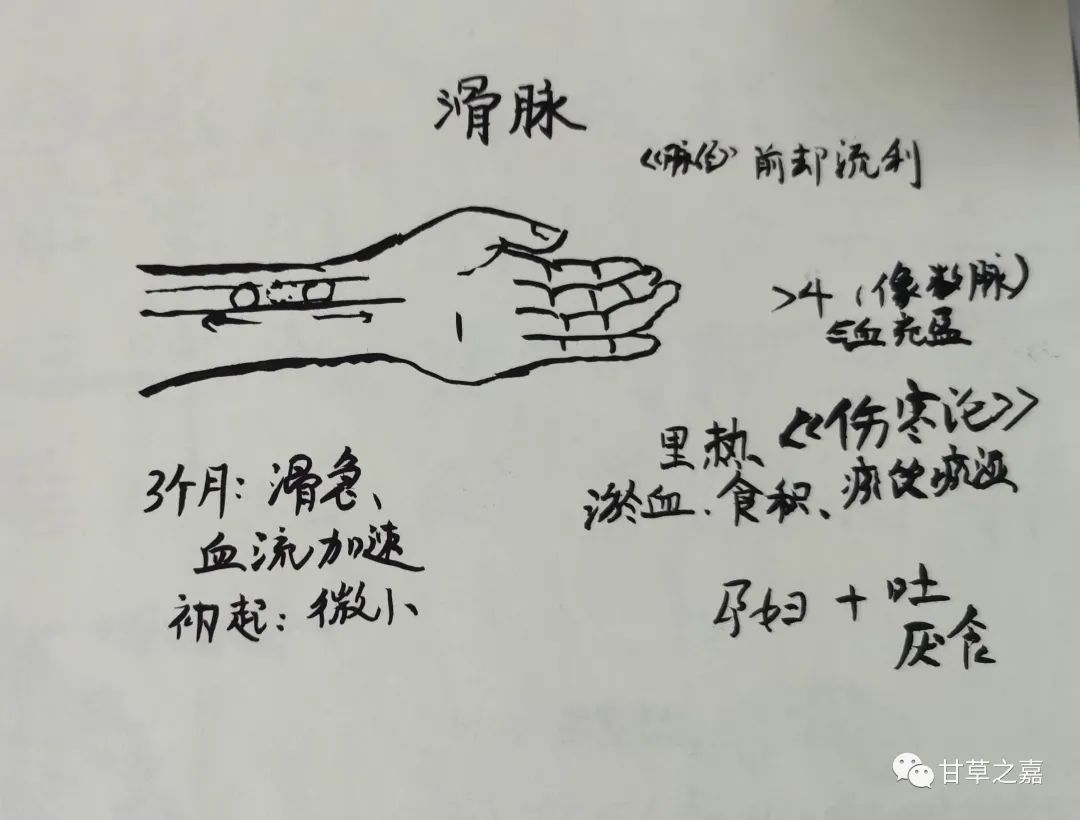I’ve seen many jokes and nonsensical questions about the slippery pulse, and I truly find it hard to respond, so I decided to write a commentary on it. To ensure accuracy and clinical practicality, I also spoke with a friend from my apprenticeship class. We signed our apprenticeship contracts around the same time, but she has been practicing for a longer period than I have. She has been studying under an 80-year-old gynecological TCM expert for ten years in Jiaxing. If friends in Jiaxing need gynecological consultations, they can ask me for her contact information.
(My teacher’s clinic mainly focuses on tumor and postoperative care patients, but there are also many internal medicine patients. However, my friend specializes in TCM gynecology, so she has more clinical experience in this area. For basic questions, I didn’t want to bother my teacher, so I sought to discuss and explore with classmates.)
Now, let’s start the discussion. Please fasten your seatbelts, we are about to begin.
1 What is a slippery pulse? What does it feel like?
First of all, it’s difficult to describe this sensation in words; one can only truly understand it through experience. It’s like the feeling of love—something that can only be felt, not easily articulated.
However, skills cannot rely solely on feelings for transmission, so we still need to use words. But information can be compressed or misunderstood when conveyed through language. This is the limitation of language mentioned at the beginning of the Dao De Jing.
The Huangdi Neijing states, “In the six changes of disease, a slippery pulse indicates abundant Yang Qi with slight heat,” and “a rough pulse indicates excess Yang Qi, while a slippery pulse indicates excess Yin Qi.” A slippery pulse is a type of pulse manifestation characterized by smooth and flowing sensations, akin to pearls rolling and rotating. The Mai Jing describes it as, “Flowing smoothly back and forth, resembling pearls responding to fingers, fluid and slippery as if wanting to escape” (as illustrated).

Its characteristics include: frequency, often more than four beats per breath, and a smooth, rolling sensation like beads rolling under the fingers, spiraling forward. Among various pulse studies, the description in Binhu Pulse Studies is the most comprehensive and least ambiguous, explaining that “the pulse is the residence of blood; when blood is abundant, the pulse is slippery.”
2 The Principles and Applications of Slippery Pulse
I checked several books and resources, but none explained it particularly clearly. So, I will write some explanations based on my understanding. If there are any errors or omissions, please feel free to correct me.
The slippery and rough pulses reflect the smoothness of the pulse and its degree. Their characteristics of frequency and smoothness correspond to the internal logic of abundant Qi and blood.
The appearance of a slippery pulse indicates that there are tangible substances filling the body, such as phlegm, food stagnation, or a fetus. (Generally speaking, absence = Yang, presence = Yin; inch = Yang, cubit = Yin. Normally, following the pathway of the Taiyin Lung Meridian, the direction is towards the fingertips. If blood vessels are likened to water pipes, your hand will help you see this water flowing smoothly.) A slippery pulse, being an excess of Yin, can also correspond to this understanding. Moreover, thousands of years of experience have proven that a slippery pulse is primarily associated with the following patterns.
First: Slippery pulse indicates phlegm, which is the most common cause of a slippery pulse in clinical practice. Phlegm is a clear sign of excess Yin Qi.Second: Heat in the Qi level (excess heat/interior heat) affects the blood level, with Yangming being the most common in clinical practice. Heat invading the Qi level causes the internal Qi mechanism to become rapid, and this rapidity is often manifested in the form of pulse frequency. When the pulse does not noticeably speed up, it can lead to accelerated blood flow, resulting in a slippery pulse. The Shanghan Lun states in section 217, “In Yangming disease, if there is delirium, tidal fever, and a slippery and rapid pulse, Xiao Chengqi Decoction should be used.”Third: Food stagnation. The Shanghan Lun states in section 256, “A slippery and rapid pulse indicates food stagnation.” Slippery pulse due to food stagnation is more common in children, as food is also a form of Yin. The slippery pulse associated with food stagnation is particularly evident in the right hand at the guan and chi positions (stomach), often accompanied by a feeling of stagnation. Treatment focuses on unblocking the intestines and resolving stagnation. The above three points are the main inducements for a slippery pulse, all primarily based on a pathological mechanism of excess Yin Qi.3 Why is a slippery pulse often considered a sign of pregnancy?
Generally, in women who have missed their period for 45 days and are pregnant, the pulse will exhibit a smooth and flowing sensation, akin to beads rolling smoothly, which is a phenomenon caused by the abundance of Qi and blood after pregnancy. Therefore, people often consider a slippery pulse as a sign of pregnancy.
However, first, slippery pulse does not equal a sign of pregnancy. The second question above addresses this. In fact, the underlying reason for a slippery pulse is the fullness of Qi and blood, or the presence of tangible substances within the body, or internal heat. Thus, some healthy young individuals may also exhibit a slippery pulse; yes, boys can also have a slippery pulse!
Secondly, even during pregnancy, a slippery pulse is not present throughout the entire term. I have researched a lot of information and asked many people. There are no particularly clear data, so this is for reference only. Traditional Chinese medicine does not have the same data-to-problem correspondence as Western medicine. It varies from person to person. Generally, the earliest a slippery pulse can be detected is 3-7 days after a missed period; sometimes, a slippery pulse may indeed appear earlier than a positive urine hCG test. However, as mentioned above, a slippery pulse does not guarantee pregnancy, so it is essential to consider other factors comprehensively. Under modern medical conditions, to avoid medical disputes, blood/urine tests are often conducted. Sometimes, pulse manifestations can also reflect the fetus’s condition; skilled doctors can detect whether a patient is at risk of miscarriage due to insufficient Qi and blood and take preventive measures.
In the early stages of pregnancy (especially noticeable in the first three months), some say it becomes more apparent in the later stages. As for which hand shows it more clearly, both hands can exhibit it. The left side (corresponding to the heart, liver, and kidneys) may be more pronounced, while the right side (stomach) may be more evident in heavier pregnant women. These details depend on personal experience and ability, and they vary according to the patient’s age and body type. Non-professionals need not be overly concerned.
Combining with the previous article where I introduced the four diagnostic methods (observation, listening, inquiry, and pulse), let’s do a practical exercise:

What to do if a suitable woman has a slippery pulse?
The most direct approach is to gently ask if she is trying to conceive, and for safer medication, whether she would be willing to do a urine test.
We can also observe her complexion, body type, and ask if she has gained weight recently. Is her menstruation regular? If she has regular menstruation + missed period + slippery pulse + fatigue, abdominal pain, breast tenderness, nausea, and vomiting, then the likelihood of pregnancy is very high. It is important to note that women may exhibit a slippery pulse during their menstrual period or within three days before and after menstruation, as well as during ovulation. Therefore, one should not rely solely on pulse diagnosis to determine pregnancy; it is best to consider all four diagnostic methods together. Additionally, given that the doctor-patient relationship may not be very harmonious, healthcare professionals should take care of themselves. Avoiding risks and conducting necessary examinations is not only responsible for the patient but also protects oneself. It is also part of standard medical procedures.
4 Can pulse diagnosis determine gender?
Without discussing the level of skill or accuracy, even ultrasound does not reveal gender, as it involves ethical considerations. The secrets of heaven cannot be disclosed; whether a boy or girl is a matter of fate, and both intelligence and ordinariness are results of cause and effect. Those who are clever and capable may have to work harder, while those with ordinary qualities may not necessarily be at a disadvantage; a life without waves can also be a form of joy.
However, if an experienced TCM practitioner truly wants to determine gender, they have their own methods. But generally, it is not 100% accurate; the accuracy may be relatively higher after 2.5 months. Too early, and ultrasound cannot detect it. It is said that “the fetal pulse… if the left pulse is rapid, it indicates a boy; if the right pulse is rapid, it indicates a girl.” In pulse diagnosis, the male and female pulses are similar, but the cubit differs; Yang is weak, and Yin is strong, with the left governing officials and the right governing households. The left is generally for boys, and the right is generally for girls.
What I mainly want to convey is not to mythologize pulse diagnosis, such as determining gender with a mere touch, or predicting the size of nodules or the metastasis of tumors (it seems some are researching this area). I hold a neutral opinion on this, as there are always mountains beyond mountains and people beyond people. In ordinary medical practice, we generally assess floating, sinking, slow, and rapid pulses to determine exterior and interior conditions of cold and heat.
Finally, “A name that can be named is not the eternal name.” Pulse names are merely for discussion purposes, serving as a label for a topic. Therefore, I hope that after reading this article, you will no longer equate a slippery pulse with pregnancy.

